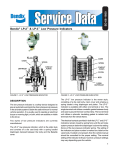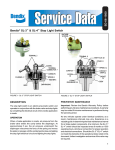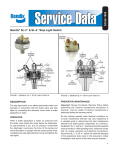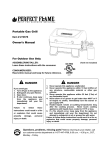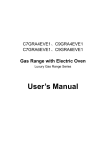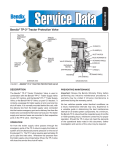Download BENDIX SD-06-1600 User's Manual
Transcript
SD-06-1600 Bendix® LP-2™ & LP-3™ Low Pressure Indicators COVER DIAPHRAGM COVER SPRING CONTACT POINTS SPRING CONTACT POINTS PISTON BODY BODY O-RING DIAPHRAGM FIGURE 1 - BENDIX® LP-2™ LOW PRESSURE INDICATOR FIGURE 2 - BENDIX® LP-3™ LOW PRESSURE INDICATOR DESCRIPTION employs a spring loaded o-ring diaphragm and piston. The LP-3™ indicator is available with either one terminal or two. The single terminal unit utilizes a metallic gasket between body and case to ground the lower contact strip. The two terminal unit utilizes a phenolic insulating gasket to isolate both terminals from the vehicle frame. The low pressure indicator is a safety device designed to give an automatic warning to the driver whenever air pressure in the air brake system is below the safe minimum for normal vehicle operation. It is usually used to operate an electrical buzzer or warning light, or both, which are audible or visible to the driver. Two styles of low pressure indicators are currently manufactured. The Bendix® LP-2™ low pressure indicator, which is the older style, consists of a die cast body with a spring loaded diaphragm clamped between the body and the Bakelite cover. The Bendix® LP-3™ low pressure indicator is the newer style. It consists of a die cast body, nylon cover and The electrical contacts provided in both the LP-2™ and LP-3™ indicators remain closed by spring force until the air brake system pressure below the diaphragm is above the setting (force) of the low pressure indicator spring. The setting of the indicator and piece number is marked on a label on the valve body. If a label is not present, then the vehicle manual should be consulted for the proper setting. The nominal setting of the indicator is 60 psi; however, pressure settings may vary depending upon the vehicle. 1 OPERATION To describe the operation, we shall assume that the low pressure indicator is set for 60 psi. When air pressure at the supply port and under the diaphragm is above 60 psi, the electrical contacts remain open because the force exerted by air pressure underneath the diaphragm overcomes the force exerted by the spring above the diaphragm. 4. Disconnect the electrical connections at the low pressure indicator. 5. Disconnect the air line and mounting bolts or unscrew the Indicator from the fitting and remove. INSTALLING 1. Install in a convenient location for servicing. When air pressure below the diaphragm drops below 60 psi, the spring exerts a force which is greater than the force exerted by the air pressure below the diaphragm. This causes the diaphragm (and the piston in the Bendix® LP-3™ indicator) to move and allow the electrical contacts to close. This completes or closes the electrical circuit to the warning device, warning the driver of low air pressure in the system. 2. Connect to a reservoir pressure line at a high point in the system for adequate drainage. PREVENTIVE MAINTENANCE NOTE: It is generally recommended that the low pressure indicator, if faulty, be replaced with a new unit; however, service parts are available; and if repairs are necessary, the following will apply: Important: Review the Bendix Warranty Policy before performing any intrusive maintenance procedures. A warranty may be voided if intrusive maintenance is performed during the warranty period. No two vehicles operate under identical conditions; as a result, maintenance intervals may vary. Experience is a valuable guide in determining the best maintenance interval for air brake system components. At a minimum, the low pressure indicator should be inspected every 6 months or 1500 operating hours, whichever comes first, for proper operation. Should the low pressure indicator not meet the elements of the operational tests noted in this document, further investigation and service of the valve may be required. TESTING FOR SERVICEABILITY OPERATING TEST 1. If possible, determine the setting of the low pressure indicator by referring to the label on the valve or the vehicle manual. 2. Operation of the low pressure indicator may be checked with ignition switch “on” by reducing the system pressure and observing that low pressure warning occurs when system pressure drops below the setting of the low pressure indicator. The contacts will be closed when the warning device operates. If the setting of the indicator is unknown, the contacts should close between approximately 70 psi and 50 psi. LEAKAGE TEST 1. With air pressure present at the supply port, coat the indicator with a soap solution. No leakage is permitted. REMOVING 1. Block the wheels or secure the vehicle with other than service brakes. 2. The ignition switch should be in the “off” position. 3. Drain the air from the system. 2 3. If installing a Bendix® LP-2™ indicator, use a supply line of 1/4” O.D. minimum. 4. Connect the Indicator terminals in series with the ignition switch and the warning device. DISASSEMBLY LP-2™ indicator. Unscrew the cover retainer from the body. Remove cover and remove spring and diaphragm assembly. LP-3™ indicator. Remove cover screw and lockwashers. Remove the cover, contact disc, spring, and shim(s). (Note: shims may or may not be present.) Remove contact plate, gasket, piston, and o-ring diaphragm. CLEANING AND INSPECTION 1. Clean all metal parts in mineral spirits and dry them completely. 2. Inspect all parts for excessive wear or deterioration. Check the valve spring for cracks or corrosion. 3. Inspect contact points. If contact points are not severely pitted, they can be dressed with a fine file. Replace all parts that were discarded and any parts not found to be serviceable during inspection, using only genuine Bendix replacement parts. ASSEMBLY NOTE: When using pipe thread sealant during assembly and installation, take particular care to prevent the sealant from entering the valve itself. Apply the sealant beginning with the second thread back from the end. BENDIX® LP-2™ INDICATOR 1. Place and position the diaphragm assembly in the body. Position the spring so that it rests on the upper diaphragm follower. 2. Place the cover over the diaphragm and screw the cover retainer to the body and tighten securely. (Torque to 110-130 inch pounds.) BENDIX® LP-3™ INDICATOR 6. If shim(s) are used, place shim(s) in cover. 1. Lubricate the bore of the body and both sides of the o-ring diaphragm with silicone lubricant BW-650-M (Bendix piece no. 291126). 7. Place the spring in the cover. 2. Install the o-ring diaphragm in the body. (Note: the o-ring portion of diaphragm should face the supply port.) 3. Install the piston in the body. The flat side of the piston should face the o-ring diaphragm. 4. Install the gasket. (Always use a phenolic gasket in a two terminal switch and a metallic gasket in the single terminal switch.) 5. Position the contact plate over the fingers of the piston. The contact plate should rest on the face of the gasket. 8. Place the contact point so that it rests on the spring. 9. Install the cover on the body using the machine screws. Make certain that the contact plate is in position over the fingers of the piston and the arm of the contact plate is positioned so that it will fit in the groove of the cover. 10. Tighten the screws securely. (Torque to 20-30 inch pounds). TEST OF REBUILT LOW PRESSURE INDICATOR After rebuilding, perform the leakage and operating tests as outlined in the section entitled “Testing for Serviceability.” 3 4 BW1447 © 2011 Bendix Commercial Vehicle Systems LLC All rights reserved. 6/2011 Printed in U.S.A.




